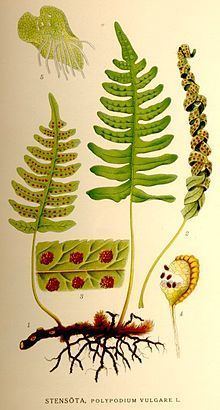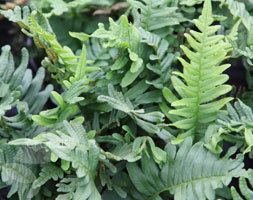Genus Polypodium Higher classification Polypodium | Division Pteridophyta Scientific name Polypodium vulgare Rank Species | |
 | ||
Similar Polypodium, Dryopteris filix‑mas, Athyrium filix‑femina, Dryopteris, Asplenium scolopendrium | ||
Polypodium vulgare
Polypodium vulgare, the common polypody, is a fern of the Polypodiaceae family. Polypodium vulgare is an allotetraploid species, believed to have arisen by chromosome doubling of a sterile diploid hybrid between two ferns which are not known in Europe. The fern's proposed parents are the northern Asian and northern North American Polypodium sibiricum and western North American Polypodium glycyrrhiza. Biochemical data point to a species from eastern Asia as the second possible parent. The name is derived from poly (many) and pous, podos (a foot). Polypody has traditional uses in cooking for its aroma and sweet taste, and in herbal medicine as a purgative and vermifuge.
Contents
- Polypodium vulgare
- Polypodium vulgare time lapse
- Description
- Geographical distribution
- Habitat
- Uses
- Note
- References

Polypodium vulgare time lapse
Description

Polypodium vulgare, the common polypody, is a fern developing in isolation from along a horizontal rhizome. The fronds with triangular leaflets measure 10 to 50 centimetres. They are divided all the way back to the central stem in 10 to 18 pairs of segments or leaflets.
The leaflets become much shorter at the end of the frond. The leaflets are generally whole or slightly denticulated and somewhat wider at their base, where they often touch each other. They have an alternating arrangement, those on one side being slightly offset from those on the other side. The petioles have no scales.
The sori are found on the lower side of the fronds and range in colour from bright yellow to orange. They became dark grey at maturity.
Geographical distribution

The common polypody occurs throughout western Europe and North Africa.[1] It is very common in France, where it is found up to an altitude of 2,000 metres (6,600 ft). It is also quite common in Scandinavia and Carpathian Mountains. It is an introduced species in New Zealand, that has begun to spread into the wild as an invasive species.
Habitat

This fern is found in shaded and semi-shaded locations. It is found on old walls, cracks in rocks, the bases of trees and in rocky undergrowth. It prefers sandy soils and rarely tolerates lime.
